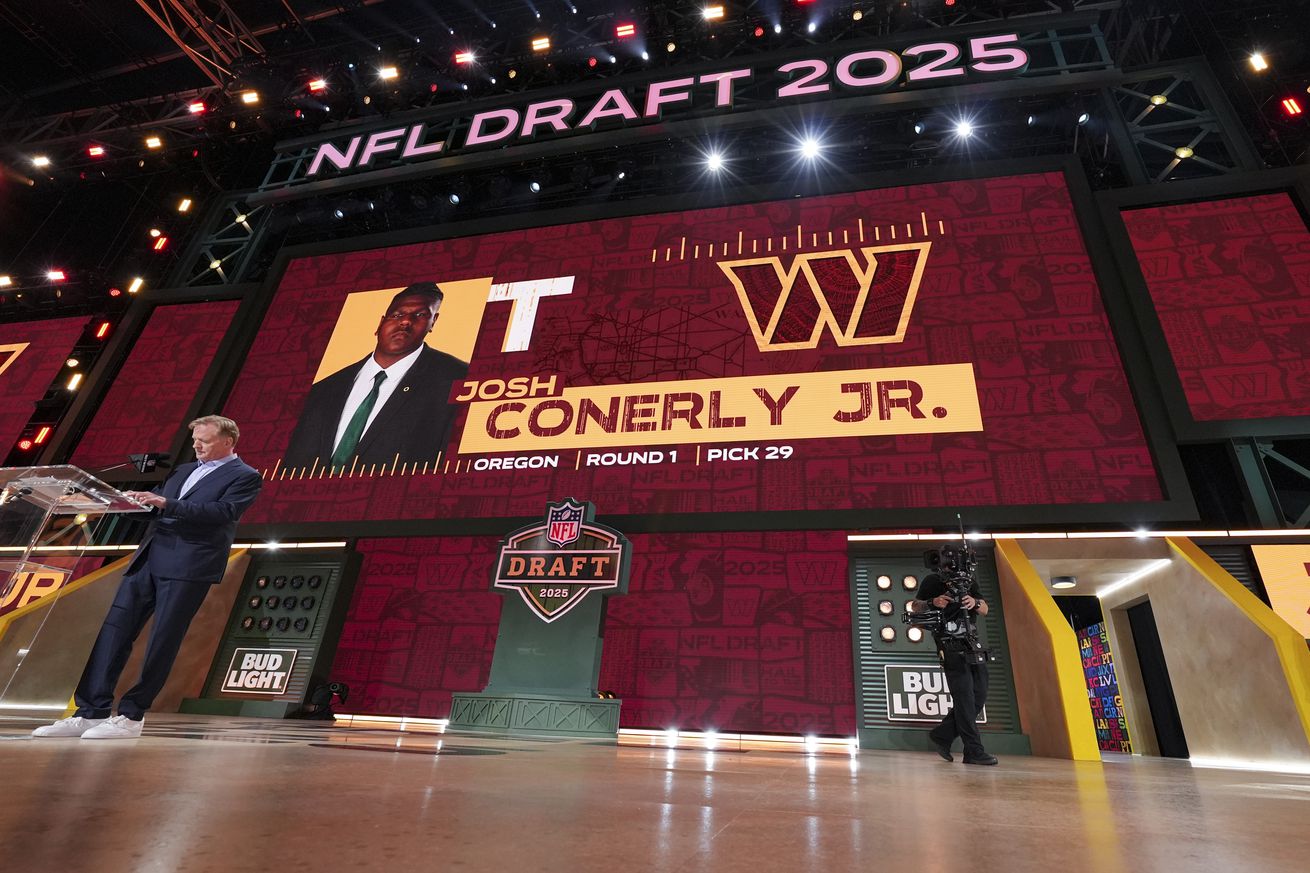
Exploring the duality of Washington football fandom
With the 2025 NFL draft officially in the books, it is time for the annual ritual of instant draft grades. Grading a draft before the players have even taken the field is obviously meaningless due to the timeline of player development and the unpredictability of outcomes.
But how much fun is waiting two years to pass judgement?
Two years from now we will all have forgotten how upset we were that Adam Peters didn’t draft the edge rusher the team obviously needed, opting instead to pick a player at the position that we were upset he didn’t address last year, despite not having a second pick in the first round when all the top prospects went off the board.
It is best to strike these things while the iron is hot.
Last year, in an effort to help the DraftBot through an existential crisis prompted by Dan Snyder being replaced by competent management, I convinced my cybernetic friend/creation to indulge in the irrational exercise of snap grading the Commanders’ draft. It’s logic circuits initially struggled with the concept, but it eventually warmed to the concept.
This year we decided it would be even more fun to do snap grades together. The DraftBot is a marvel of modern science and technology. It’s fifth generation bio-cybernetic neural network processor is the pinnacle of computing technology. It will grade the logic and draft strategy of the Commanders picks.
I was trained as a neuroscientist, but was also raised as a second generation Redskins fan, and came of age during the glory years of the 1980s. My idea of what kind of players a team needs to win championships hasn’t changed much since Dexter Manley terrorized quarterbacks and John Madden waxed philosophic about Dave Butz’s helmet. I like physically dominant offensive linemen, nose tackle, safeties who hit like there’s no concussion protocol, big-ass receivers to outmuscle defensive backs, and most of all, fullbacks.
I do admit to having a soft spot for zippy receivers and return guys, as long as they can make tough catches and hang onto the football.
I will lean into my inner ‘80s Redskins homer for the snap grades and mostly leave the rational analysis to the DraftBot.
Grades on Individual Picks
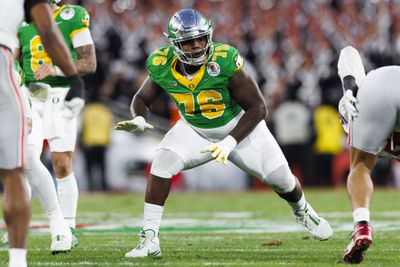
Photo by Ric Tapia/Getty Images
Round 1, Pick 29 – OT Josh Conerly, Oregon
6-5, 311 lbs | 33.5” arms | 1.70 sec 10-yd | 34.5” vertical | 24 reps bench | RAS 8.86
Consensus Rank: 33
DraftBot Rank: 27/181
DraftBot Grade
Conerly is an athletic tackle who fits offensive coordinator Kliff Kingsbury’s preference for offensive linemen who can pull and get downfield to hit defenders at the second level. He has excellent footwork and is well developed in pass protection. However, he may need to add play strength to improve his anchor against NFL defenders. Adam Peters commented that he played well against highly rated defenders, including the top pass rusher in the draft class, Abdul Carter.
Conerly is a young prospect with upside to develop into a franchise player at the position with the second-highest replacement cost. There is some doubt about how soon he will be ready to start, to be resolved in training camp and preseason. However, the team has options to man the RT position until he is ready to start, if needed.
According to Peters, the team had trade offers on the table, but had decided ahead of the draft that they would make the pick if Conerly or one other player who was available were still on the board. According to my draft board, there were other high-impact players with early starting grades on the board when the Commanders made the pick, including LB/Edge Jihaad Campbell, S Nick Emannwori, Edge Donovan Ezeiruaku and CB Tre Amos. Peters’ comments indicate that Conerly was rated well ahead of these or other players.
Like Peter’s first pick for the Commanders, this pick is an investment in the future. Picking a player at a premium position who provides an ideal fit to the offensive scheme and coaching preferences, while prioritizing long-term impact over immediate need exemplifies best practice drafting. Grade: A
MiBV Grade
The DraftBot is right, of course. With unanimous support from the coaching and scouting staffs, Conerly was the logical pick. He has the traits and upside to be developed as a starting left tackle, down the road, in which case this pick becomes a home run. But choosing a finesse OT with Jihaad Campbell and Nick Emmanwori on the board leaves me feeling like I ended up ordering the salmon when there were some good red meat options on the menu. AP gets half a point extra for focusing on long-term upside and impact, rather than reaching to address an immediate need. Grade: B+
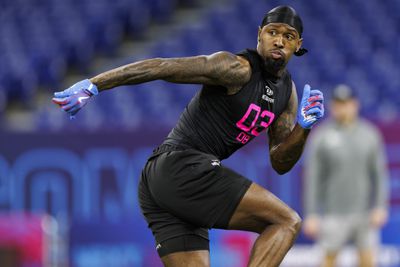
Photo by Brooke Sutton/Getty Images
Round 2, Pick 61 – CB Trey Amos, Ole Miss
6-1, 195 lbs | 4.43 sec 40 | RAS 8.85
Consensus Rank: 36
DraftBot Rank: 26/181
DraftBot Grade
Amos is exactly the type of long, physical man cover corner that Dan Quinn has utilized in his defenses in Seattle and Dallas. His addition gives the Commanders a physical presence on both boundaries, allowing Mike Sainristil to move to his natural position at nickel to complete Joe Whitt’s starting CB lineup.
Like Peters, I had Amos rated in the first round and would have taken him at 29, as I did in my mock draft. Getting him here is exceptional value. He was well ahead of the next rated player on my board at this pick. Grade: A+
MiBV Grade
I love this pick. Amos has been one of my favorites throughout the draft process, and fufills the expectation that was established when Dan Quinn was announced as the head coach hire. He provides the best balance of ball production and lockdown coverage in the draft class after the early first round. Joe Whitt Jr. gets the big, physical boundary CB he needs to run his coverage schemes and intercept the football. The Commanders will be hard to throw against. Grade: A+
BTW, in his Day 2 presser, AP said that the analytics team loved Amos, and specifically mentioned that he stood out in Yards per Coverage Snap. That is the very same metric I have been promoting to measure lockdown coverage. In my roundup of Ballhawking CBs the Commanders Must Draft, Amos was revealed to be very stingy in coverage, allowing just 0.544 Y/Cov Snp, which placed him in the top 6.5% of draft-eligible CBs. I thought I was the only one using Y/Cov Snp. Turns out, great minds think alike.
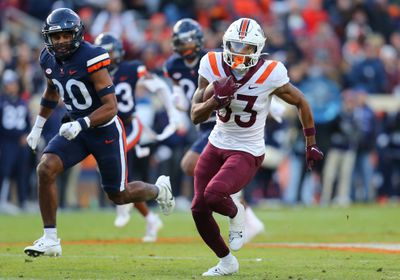
Photo by Lee Coleman/Icon Sportswire via Getty Images
Round 4, Pick 128 – WR/PR Jaylin Lane, Virginia Tech
5-9.6, 191 lbs | 4.34 sec 40 | 1.53 sec 10-yd | RAS 9.56
Consensus Rank: 169
DraftBot Rank: 135/181 (rd 5/6)
DraftBot Grade
Lane is a slot receiver with break-away speed and additional value returning punts and running out of the backfield. Lane is a legitimate big play threat with the ball in his hands, with a resume full of long gains and 2 punt return TDs.
Lane has elite level athleticism and contact balance, and excels at gaining yards after the catch and making big plays on punt returns. His average YAC per reception tied for 4th highest among ranked WR prospects. He is adept at evading tacklers and breaking arm tackles, and has good body control to catch off-target passes.
He is fearless in attacking the middle of the field and turning upfield on punt returns, but is poor at making contested catches due to sub-optimal play strength. Also, for a receiver who specialises in shorter routes (ADOT 7.5 yds), his 65.5% reception rate is somewhat below expectation ( -7.5% RROE), raising questions about his hands.
Lane has a path to see the field early as a return specialist, and potentially upgrades the positon. On offense, he gives Jayden Daniels another two-way threat to stretch defenses vertically.
The Commanders were obviously higher on Lane than my scouting department was. While Layne’s potential to upgrade the return game should not be underestimated, at this point in the draft, I had much higher grades on many players, including WRs Jalen Royals and Tory Horton, OL Marcus Mbow, Edges Bradyn Swinson and Elijah Roberts, and even DTs Cam Jackson and J.J. Pegues.
I am beginning to wonder whether the issue is with Adam Peters’ decision, or my scouting department. Grade: C-
MiBV Grade
I am higher on this pick than the DraftBot. Lane puts an explosive, big play threat on the field on offense and special teams, which is something that had been in short supply. Plus, I have been pounding the table for the Commanders to add a dynamic return man since as far back as I can remember. I like the tough-nut mentality, but the inability to make contested catches and the questionable hands give me pause.
There were a lot of players I liked better here, including Colorado WR Tory Horton, who was a more productive receiver, and is also a talented return man, but dropped to the end of the fifth round due to season ending knee surgery.
Fortunately, I have greater confidence in Adam Peters’ ability to evaluate NFL talent than my own. Now that he’s a Commander, I will be cheering for Jaylin to prove me wrong. Grade: C+
Round 6, Pick 205 – LB Kain Medrano, UCLA
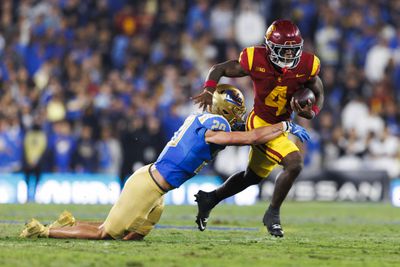
Photo by Ric Tapia/Getty Images
6-3, 222 lbs | 4.46 sec 40 | 1.52 sec 10-yd | RAS 9.83
Consensus Rank: 203
DraftBot Rank: unranked
DraftBot Grade
Medrano aligns with Adam Peter’s prototype for late Day 3 picks: lengthy college experience, team captain, freakish athleticism, early value on special teams. He was not on my board, so I had to send my scouting department back to work to give me a rundown.
Medrano profiles as a special teams player with developmental potential on defense. He played over 100 special teams snaps in four of his six college seasons. During that time, he recorded just 3 tackles and 2 assists on ST coverage units, compared to 7 missed tackles.
Medrano has the build of a dime backer, and excels in man coverage on tight ends. He tops the charts for linebackers in speed and explosion, with very good agility numbers. Switching position to strong safety raises his RAS to 9.97.
Medrano has some positive traits to build on in run support. In 2024, his 9.2% run stop rate ranked 30th out of 113 draft-eligible Power 5 LBs. However, he had an alarmingly high rate of missed tackles against the run (19.4%, 9th highest/113 LBs), due to taking poor angles and poor tackling strength. His tackling issues were even worse on passing plays, with misses on 35.7% of attempts. His overall missed tackle rate of 26% was the highest of all Power 5 LBs (min. 189 def snaps). That’s just unacceptable.
If the Commanders linebackers’ and special teams’ coaches can teach him to tackle, he could be developed as a hybrid defender. The Commanders’ must be very confident in their coaching ability.
The top players on my board at this pick were S RJ Mickens, RB Brashard Smith, and OTs Logan Brown, Cameron Williams and Hollin Pierce.
I am puzzled by this pick. Grade: Rivera
MiBV Grade
What he said. A linebacker who can’t tackle is about as useful as a receiver who can’t catch. But I suppose plenty of those get drafted every year. There were a lot of players available here whom I thought could help the Commanders, including the guys the DraftBot mentioned, third down back LeQuint Allen, and the top run stuffing DT in the draft class, Cam Horsley. Of course, a lot of those guys went undrafted, so what do I know?
This pick is just rescued from receiving the lowest grade by virture of being in the late sixth round, where most players will fail and it is very difficult to spot the ones who won’t.
In AP we trust, I guess. Grade: D-
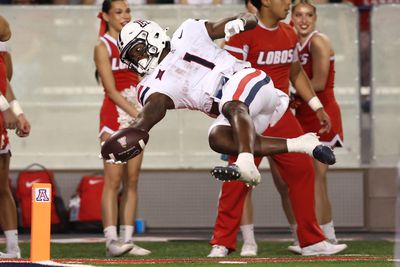
Photo by Chris Coduto/Getty Images
Round 7, Pick 245 – Jacory Croskey-Merritt, Arizona
5-10, 206 lbs | 4.45 sec 40 | 1.50 sec 10-yd | RAS 8.29
Consensus Rank: 273
DraftBot Rank: 164/181
DraftBot Grade
After two lackluster picks, Adam Peters finishes strong with a great value pick near the end of the final round.
Croskey-Merritt took a circuitous route to find his way to an NFL roster. He spent four years at Alabama State and then transferred to New Mexico in 2023 and Arizona in 2024. Unfortunately, his lone season at a Power 5 school was cut short after one game due to a questionable eligibility ruling. There is limited tape against top competition, but what is there is spectacular.
Croskey-Merritt burst onto scouts’ radar at the Hula Bowl, earning an invite to the East-West Shrine game where he was named Offensive MVP after an 11 carry, 97 yard/2 TD performance.
The tape from his most recent seasons and the Shrine Bowl reveals an explosive back with good patience, exceptional footwork and lateral agility to make tacklers miss and blow past defenders. He is a willing pass blocker, who packs a pop, but might need to work on his blitz recognition. He was not used consistently in the passing game, but showed good hands when thrown the ball.
Unlike most backs available at this point in the draft, Croskey-Merritt is a genuine home run threat when he finds an opening. He is also a secure ball handler with just 4 fumbles in 513 rushing attempts in college (0.78% fumble rate).
Croskey-Merritt turns 24 this season, making him just two years younger than fourth year lead back Brian Robinson. That would be a bigger issue at other positions, but RBs are usually only good for one contract.
If the limited tape extrapolates to the NFL, Croskey-Merritt offers what the Commanders’ RB room currently lacks: explosiveness, vision and speed. He should compete for snaps with Robinson, Jeremy McNichols and Chris Rodriguez, and has a good chance of earning playing time in a rotational role on early downs.
The Commanders finish by picking up a second likely early contributor at the end of Day 3. There were not many players left on my board with his potential impact. Grade: A
MiBV Grade
Picking a likely Year 1 contributor near the end of the 7th round is a great way to close things out.
Croskey-Merritt hasn’t put up enough tape against top quality competition to be sure that what he showed at the East-West Shrine Game will translate to the NFL. What he did show was enough to earn him four team visits with the Commanders, including a coveted Top 30 visit.
The Commanders’ rushing attack was highly variable last season, with high rushing totals against weaker teams early in the season and a fade down the stretch. Some of that was due to subpar run blocking, but the Commanders also lack a between the tackles runner who can create more than the blocking gives him. Croskey-Merritt has the potential to fill that void.
In open competition, Croskey-Merritt has potential to steal early down snaps from Robinson this season. That is tremendous value in the 7th round when teams are generally looking for special teamers with a hope of sticking at the end of the roster. Grade: A+
Overall Grades
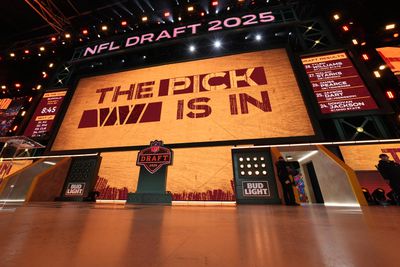
Photo by Perry Knotts/Getty Images
DraftBot
The Commanders entered this draft with just five total picks and only two in the top 100. Adam Peters expressed interest in trading to add more picks before the draft. But, as the draft unfolded, players became available at the two high-value picks who were too valuable to pass up. In this situation, not trading back simply for the sake of adding more picks maximized the return for the team’s draft capital.
To properly evaluate the draft effort, we have to include the veteran players who were acquired with 2025 draft picks. Peters used the commanders original seven picks, plus two picks acquired from the Eagles, to add the following players to the roster:
OT Josh Conerly 29
CB Trey Amos 61
OT Laremy Tunsil 79 & 236 (from Eagles), 2026 2nd & 4th
CB Marshon Lattimore 93, 131, 184
WR/PR Jaylin Lane 128 (from Texans, Tunsil trade)
WR Deebo Samuel 147 (From Saints, Lattimore trade)
LB Kain Medrano, 205
RB McCroskey-Merritt 245
The Commanders parlayed their seven original picks, plus two from the Eagles, to add eight new players. These included upgrades to both starting OT positions and both starting boundary CBs, a dynamic veteran playmaker on offense, and likely early contributors at WR/PR and RB.
There is some downside in converting long-term capital into short shelf-life assets when trading draft picks for veteran players, and the debt for acquiring Tunsil extends to next draft. But those moves were necessitated by the state in which Ron Rivera left the roster.
Overall, the Commanders’ draft capital was used to achieve a massive increase in the team’s talent level for the 2025 season, with long-term upside at two premium positions. Hopefully this off-season’s additions will get the roster over the hump, allowing the focus to shift to more long-term team building and maintenance next offseason or the following one.
Overall Grade: A
MiBV
My ideas about the kinds of players the Commanders need to become perennial contenders is distilled into my annual Little Board. Since snap grades are issued from the armchair, a list of my own personal preferences and biases makes the perfect yardstick to grade Adam Peters’ work. Let’s see how he did.
The Good
The Commanders needed to find another Long, Physical Man Corner to fulfill the promise of a physically imposing secondary which was made when Dan Quinn was hired. CB Trey Amos was the first alternate in that category, and also ticks a box as a Ballhawk to relieve Joe Whitt Jr’s frustration at the lack of turnovers.
I have been pounding the table for the Commanders to add a big play threat at punt returner for as long as I can remember. WR/PR Jaylin Lane, fits the bill, and was the third alternate in the Speedy Receiver with Special Teams Value category. He plays with a death-or-glory mindset taking the ball upfield. He also adds another weapon to stretch the field vertically as a receiver and gadget runner.
Jacory Croskey-Merritt, would have been the pick at Late Round Sleeper, if I hadn’t run out of steam at 2 am and dropped it. He still earned mention as a late round/FA option at Lead Back, and I honestly believe he has the chops to eat into Brian Robinson’s snaps, if not stealing the starting job in camp.
While AP did not draft any primary Little Board picks, picking three players mentioned in the Little Board is a new record for a Washington GM. These guys usually end up as Ravens and Packers.
The Bad
I won’t blame AP for failing to draft any Polynesians or fullbacks, since it was a weak draft for those Little Board staples. But there were some lapses.
The most egregious failure of this draft was leaving Change of Pace Back Brashard Smith on the board to pick the worst tackling linebacker in the draft class at 205. What was the thinking?
I can quibble about picking a finesse OT at 29, instead of waiting for a Bulldozing OT to help the run game later in the draft, but Conerly was so obviously the right choice that I’m going to give it a pass.
Final Verdict
The injection of talent at premium positions and key skillsets, headlined by the addition of three Little Board mentions, with the only clear lapse of judgement near the end the 6th round, deserves top marks.
Overall Grade: A
